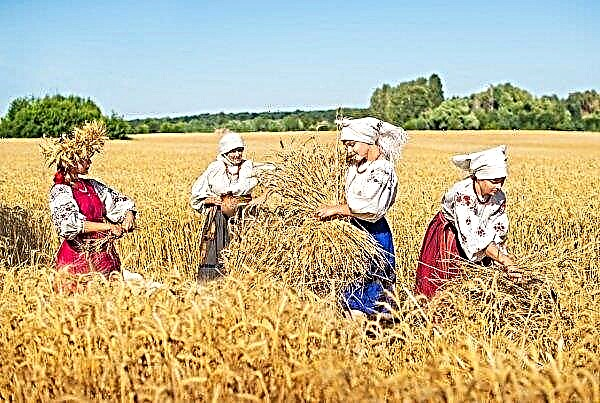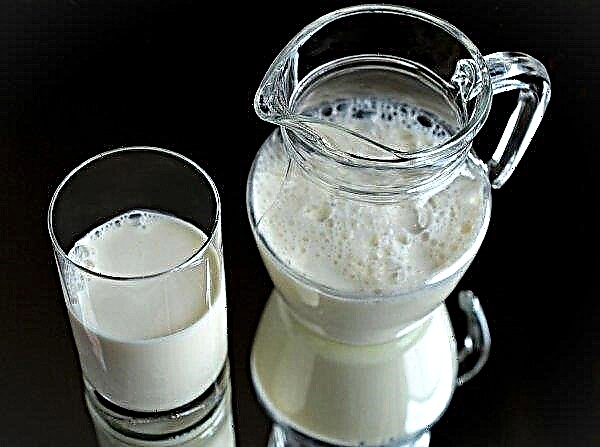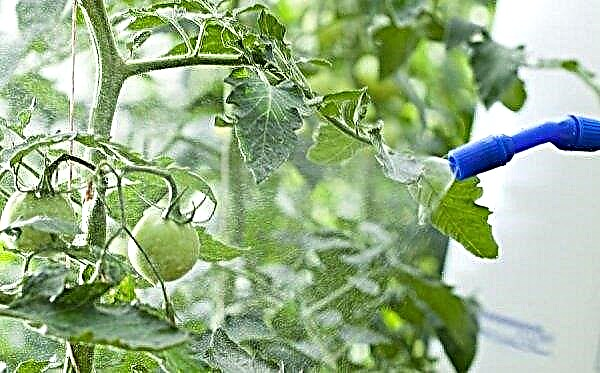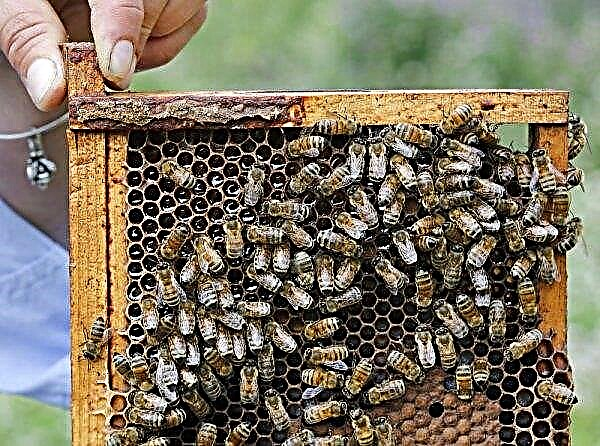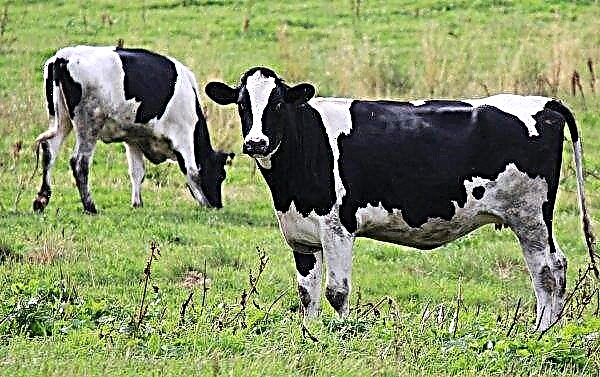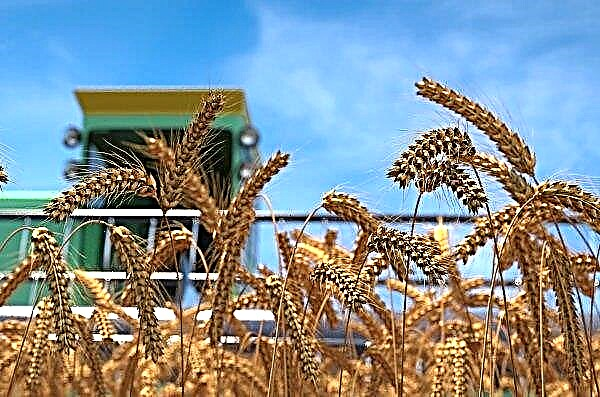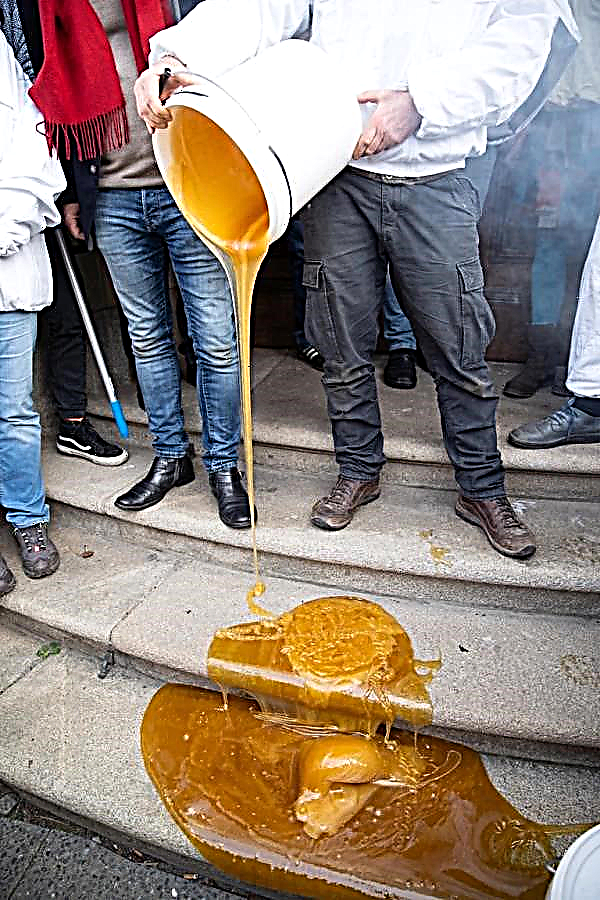If you can not decide on a variety of bell pepper for growing in your summer cottage, make a choice in favor of the universal variety White Gold. This is one of the most popular early varieties with yellow juicy fruits. Read more about the qualities of this unique culture, as well as about the features of its cultivation, read in this article.
History and description of the variety
Pepper White gold got its name due to the fact that it stands out among other vegetable crops in the garden because of its bright color. The following varietal characters are characteristic of this culture.
Selection
The variety was bred by Russian breeders specifically for cultivation in the northern regions.
Fruit Characteristics
The fruits have a cubic shape, rather large, the weight of individual specimens reaches 200–250 g, and some fruits weigh even 500 g or more. In the process of ripening, the fruit changes color: in the phase of technical ripeness, it is light yellow, slightly whitish, and ripe peppers are painted in an intense pearl yellow tone. The taste of the vegetable is delicate, with a pleasant aroma. The pulp is juicy, the wall thickness reaches 10 mm.
Due to the dense skin, the fruits can retain their freshness for a long period, including during transportation. The fruits of White Gold are universal in application: they can be consumed fresh in salads, subjected to heat treatment to prepare various dishes, and the dense structure of the pulp allows you to prepare high-quality preservation from them.
Did you know? Chocolate and bell pepper have similar properties: both of them increase the concentration of endorphins (hormones of happiness) in the blood. Given the calorie content of chocolate, to become “happy” at the expense of pepper is more profitable for a figure.
Bush characteristics
The bush is compact, medium-tall, reaches a height of 50 cm. The trunk is strong, can withstand a lot of weighty fruits. Leaves of medium size are distinguished by a slight wrinkling and light green color. The presented culture belongs to the group of early ripe varieties. Technical maturity occurs 100-110 days after the appearance of the sprouts, the fruits in this phase can already be consumed. After 2 weeks, the phase of biological maturity begins. When grown in an open area, you can collect 4.2 kg of peppers from 1 m².
Advantages and disadvantages
- Among the advantages of White Gold pepper, farmers note:
- good yield;
- high commercial qualities - especially large thick-walled fruits with rich color and wonderful taste;
- ease of care, which is available even to novice summer residents;
- strong and compact bushes;
- universality of application;
- fruit keeping and transportability.
The variety has virtually no flaws. The only caveat - to get an early and stable crop can not do without shelter, at least in early spring. Also, the plant needs at least 2-3 feeding for the entire vegetative period.
How to grow seedlings at home
Like most varieties of pepper, White gold is cultivated using seedlings. At home, growing young bushes is quite simple.
Important! For preventive purposes, in order to avoid infections, the seeds must be decontaminated before sowing in a 1% solution of potassium permanganate or in other disinfectants. After disinfecting, rinse the seeds in warm water.
The timing
The optimal time for sowing seeds for seedlings is the end of February. In extreme cases, sowing work can be carried out in early spring.
The soil
To obtain strong seedlings, you must first prepare the soil of high quality. It should be fertile, but at the same time light and breathable. When preparing the soil yourself, mix turf soil and humus or compost, introduce ash and mineral fertilizers. To add friability to the clay soil, pour sawdust or sand. Suitable acidity for growing peppers is around 6.4 pH. Before sowing, the soil mixture must undergo a disinfection procedure. Treat it with a solution of potassium permanganate (1-2%), after which additional treatment with a biological preparation (Trichodermin or Planriz) is recommended. If the soil was taken from the garden, pour it with a fungicide solution (for example, “Fitosporin”).
Before sowing, the soil mixture must undergo a disinfection procedure. Treat it with a solution of potassium permanganate (1-2%), after which additional treatment with a biological preparation (Trichodermin or Planriz) is recommended. If the soil was taken from the garden, pour it with a fungicide solution (for example, “Fitosporin”).
Capacity
For sowing seeds, you can use any container, but it is better to plant them in large boxes. The tank should have several drain holes - they will provide the young root system with comfortable conditions.
Seed selection and preparation
To seedlings successfully sprouted, the choice of seeds should be approached responsibly. When buying planting material, study the packaging - it must necessarily indicate in which climatic environment this variety of pepper can be grown, the time of ripening of seeds and the rules for sowing. Pay attention to the manufacturer, preferring a well-known company.
Important! When growing white gold pepper seedlings, it is especially important to protect delicate sprouts from temperature extremes. Optimal temperature for seed germination — +20 ... + 25 ° С.
Soak the pure seed additionally in a growth stimulator (in wood ash or organic fertilizer "Effekton"). Prepared seeds can be germinated by keeping them for some time in a damp cloth at a temperature of +25 ... + 27 ° С. The procedure will help accelerate the emergence of seedlings.
Sowing seeds
Sowing is done in holes with a depth not exceeding 1 cm, after which future seedlings need to be watered and covered with a polyethylene film. The distance between the holes is 2-3 cm. Leave the seed container in a warm place until the first shoots appear.
Seedling Care
The sprouted White Gold sprouts require maximum illumination - light will help to prevent the sprouts from stretching. If there is a lack of natural light, use artificial sources. To increase immunity and resistance to future external threats, plants need to be hardened. Proceed to the procedure 1 week before planting: take out a box with plants on the street and leave it there for a start no longer than a few minutes.
Gradually, the time spent seedlings on the street must be increased. Water the young bushes with warm water as the top layer of the earth dries. Try not to overmoisten the soil. Apply fertilizer at the same time as watering. Top dressing is carried out 1-2 times for the entire period of growing seedlings. Good results are obtained with calcium nitrate fertilizer. With the advent of several real leaves, pepper seedlings need to be dived into separate containers.
Did you know? Trying to find out which variety of bell pepper seems sweeter to people, Italian scientists conducted a study among volunteers. Most participants opted for yellow fruits. In fact, most of the sugar is concentrated in red varieties. However, it is yellow color that causes a person to associate with ripeness and sweetness.
How to transplant seedlings to a permanent place
When the seedlings of pepper have grown and strengthened, it is necessary to transplant it into the environment most comfortable for this plant, while observing the timing and planting pattern.
The timing
For normal development, the soil on the site should be warm enough, and the temperature of the earth at the depth of planting should not be lower than +10 ... + 12 ° С. Therefore, seedlings for planting in open ground are moved to the beds in mid-May, and earlier for greenhouses. By the time of planting, young bushes should reach the age of 65–70 days. Compliance with these deadlines will allow you to have time to grow crops in a short summer. Plant peppers on a cloudy day or evening, so that the young bushes have time to adapt a little to a new place before the sun appears.
Seat selection and crop rotation
Choose a place for pepper transplantation taking into account crop rotation - this vegetable can be planted in the old place or after the rest of the nightshade crops no earlier than 3-4 years later. The best precursors for pepper are carrots, early cabbage, legumes (except beans) and perennial herbs.
The plot should be sunny and protected from the winds. It is worth making sure that there are no underground water nearby or a large body of water. With a high occurrence of groundwater, raise the bed above the ground to a height of 30–35 cm, fencing it with boards.
Important! When planting sweet pepper in open ground, it is necessary to have covering material in stock in case of unexpected frosts. As Shelters can use film and arcs, spanbond.
Scheme and depth of landing
Transplant seedlings of White Gold using the following technology:
- Before planting young plants, well moisten and nourish the land - fill the holes with wood ash, rotted compost, mineral top dressing.
- Place the wells according to the scheme 30 × 50 cm, moisten them.
- Do not deepen the bushes below the level at which they grew in containers.
- After planting, moisten the plants again.
Video: planting pepper seedlings in open ground
How to care for landings
Pepper Care White gold is not too time consuming. Bushes require regular watering, proper top dressing, soil care and diligent formation.
Watering
Planting periodically water (at least 2 times a week). Use only warm water, since peppers negatively respond to water with a temperature below + 14 ° С. The ideal type of irrigation for the presented variety is drip.
Soil care
After each watering, carry out shallow loosening of the soil. Do not loosen deep so as not to disturb the root system of plants. It is important to monitor the cleanliness of plantings and get rid of weeds in time. To protect the soil from drying out and to prevent weeds from breaking through, mulch the soil around the bushes. The best mulch will be weathered grass, sawdust, hay.
Fertilizer application
After adapting the bushes, you need to feed them with liquid fertilizers, such as infusions of grass and mullein, diluted with water. Additionally use phosphorus-potassium compounds, ash infusions. Fertilize in moist soil at a rate of once every 2 weeks.
Bushes garter
Despite the fact that the bushes of this variety are quite strong, it is better to establish supports for them when planting. Tie the shoots to the supports to negate the risk of breaking off the stems. At the end of the season, adjust the crop by cutting flowers and poorly developed ovaries. Pruning will allow ripening available fruits. For better tillering, when the plant reaches a height of 20 cm, you need to pinch the tops.
The subsequent formation consists in the removal of stepsons, which grow below the fork, as well as weak ovaries growing inward. In order to exclude growth weakening, pluck the main bud, which is located at the branching point. As you can see, White Gold pepper has a lot of advantages. Even a novice summer resident can cope with the cultivation of the described variety. These bright vegetables will delight you with their unpretentiousness, abundant harvest and great taste.


